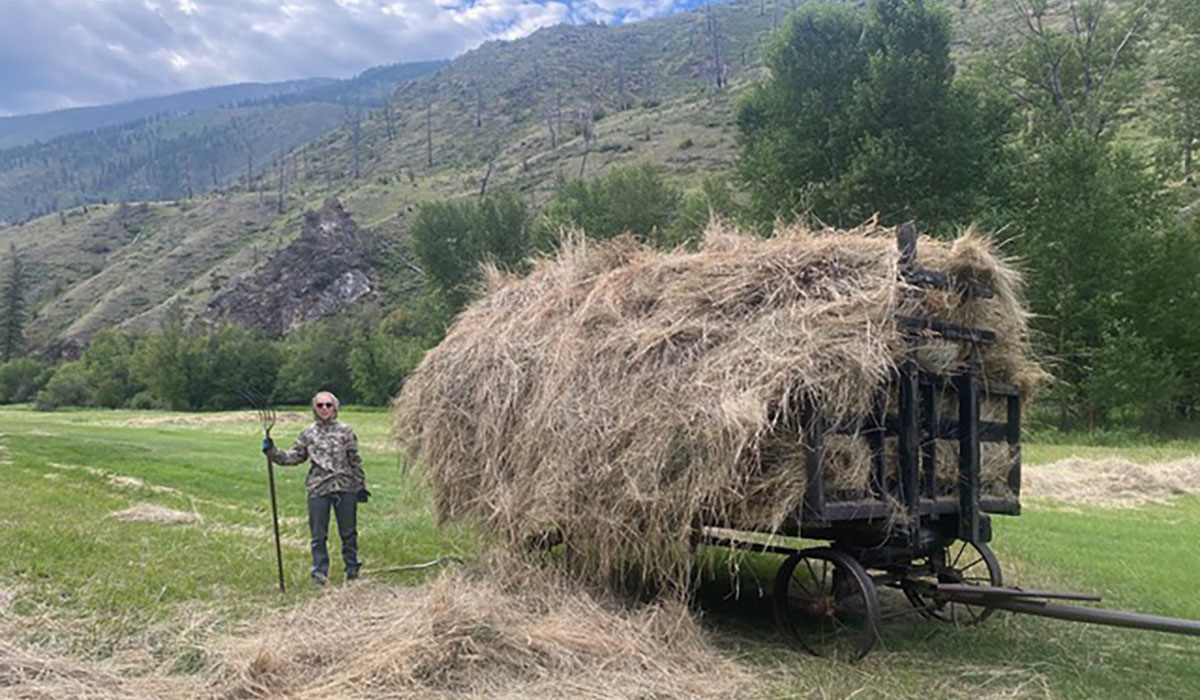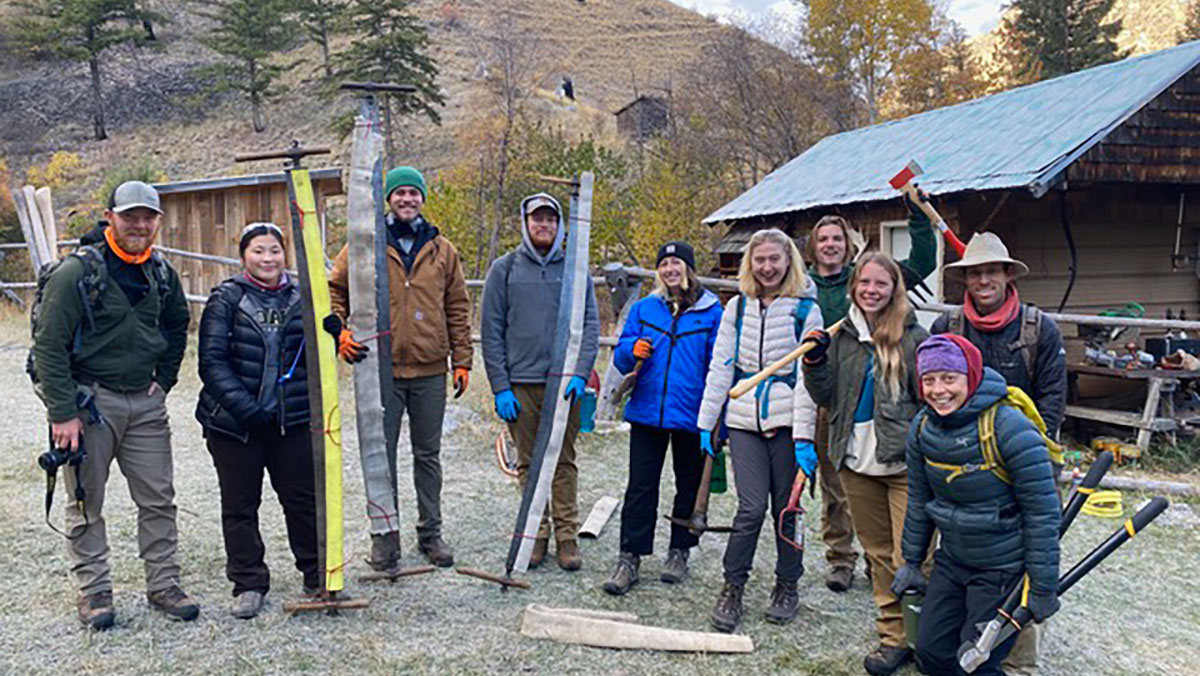Preserve Taylor’s Wilderness Legacy
Taylor Ranch Is Investing in Future Environmental Stewards
Article by Kelsey Evans, CNR Editor
Photos provided by Andrew Armstrong
Taylor Wilderness Research Station is in the heart of Idaho’s Frank Church River of No Return Wilderness — the largest contiguous wilderness area in the lower 48 states. It is the only university-operated research station located in a federally designated wilderness. As part of CNR since 1969, Taylor offers unparalleled ecosystem-based research, monitoring and education. Accessible only by light aircraft or a 35-mile hike, the field station allows long-term research and hands-on learning for students. Undergraduates in the Semester in the Wild program take an integrated set of courses in the sciences and humanities while gaining direct field experience. Undergraduate students may also assist with research projects in a variety of areas — from herpetology to fire management — through the Bleak and DeVlieg internships. Graduate student assistantship programs offer collaborative interdisciplinary research opportunities in several natural resource areas.
For doctoral student Grace Peven, Taylor Ranch is a special place.
“Taylor is the reason I applied to graduate school at U of I. With large patches of burned forest, steep rocky canyons and few maintained trails, the Frank Church wilderness is an unforgiving and difficult place for human travel. The inaccessibility of this place allows the non-human world to run through its constant cycles of disturbance, renewal and change,” Peven said. “Water is a key driver of the cycle of change here. For this reason, I was drawn to research how water and ecosystems interact to maintain wild watersheds in the Frank Church wilderness. Taylor opens access to an inaccessible place so that researchers like me can better understand how wild environments function.”
Over the next three years, we are working on securing the remainder of the funds needed to fully endow programs and operations at Taylor Ranch. Dennis Becker, CNR dean
Research at Taylor Ranch provides essential data about relationships between the earth and its inhabitants that are hard to collect in populated areas. Taylor Ranch not only serves university students, but also draws faculty from many other institutions. Idaho Fish and Game, U.S. Fish and Wildlife Service, National Oceanic and Atmospheric Administration, NASA and many other international weather and environmental monitoring entities come to Taylor Ranch to conduct independent research.
Support Taylor
To ensure that we continue offering immersive educational and research opportunities in America’s wildest classroom, CNR has embarked on a fundraising effort to raise $4 million for the Taylor Operational Endowment by 2026.
“Over the next three years, we are working on securing the remainder of the funds needed to fully endow programs and operations at Taylor Ranch. This will provide financial protection for this very special place for future generations of students and researchers. We’re planning new opportunities to share this wonderful place with more people, including life-long learners, researchers from universities and other entities, and larger numbers of U of I students,” said CNR Dean Dennis Becker.
Dennis Becker, Ph.D.
Dean and Professor of Natural Resource Policy
As of Fall 2023, generous donors have given almost $900,000 toward this $4 million endowment goal through gifts of cash, appreciated stock, required minimum distributions, qualified charitable distributions, donor advised funds, family foundations and bequest documentation as part of estate planning.
For Mary Ellen Brewick, director of development for CNR, fundraising for Taylor Ranch is one of “the best parts of her job.”
“Taylor Ranch is fortunate to have so many champions, both individuals who send charitable gifts, and private foundations who fund student scholarships and research support. Some people choose to document a bequest to Taylor when they are working on their estate plans. For example, we were recently honored by the trust of William B. Wallace to create an endowment in his name,” Brewick said. “To reach our goal of a fully funded operations endowment, we will need financial support from more of our friends and alumni. Gifts of any size make a difference to our students, so please reach out to me if you would like to discuss how you can contribute!”
Letters From Taylor
Taylor Ranch superintendent Andrew Armstrong, along with interns, is expanding research opportunities and reviving cherished traditions.
As Armstrong describes it, “winter is project time.” He and his crew work on winterizing buildings, landscaping and keeping up with the animals, tools, plumbing and pests, as well as inventory and repair of scientific instruments and generators.
“It’s time to go through files, take stock of Taylor’s history and think about how to display things that have disappeared into the shadows of Taylor’s history,” Armstrong said.
As Armstrong describes it, winter is “raw. All the wolves and predators come down and make kills on the creek. The creek is frozen in beautiful green ice. Otters come up in the holes in the ice. It’s cold and dark and a struggle for everything living. But there is stark simplicity to winter which allows for reflection and focus.”
While I was excited to greet my friend and two new colleagues, I was completely awestruck by the landscape and struggled to actively participate in the conversation. Elizabeth Herrmann, summer internship student

With spring comes new growth in the pastures and preparations for the approaching season. Prescribed burns and fuel reduction take place to protect facilities from wildfire. Game cameras are positioned, and hydrology equipment is calibrated. Graduate students from the McCall Outdoor Science School also make their annual spring trip to capstone their year-long intensive training.
Summer brings internship students, such as Jack Kreddell, Grave Peven, Bella Canifax-Broesch and Elizabeth Herrmann.
In 2022, Kreddell, an ENVS doctoral student, worked on a GIS-based archival project about Taylor that accounts for the human voices, desires and relationships that collectively inform Taylor’s history as a scientific field station.
“The goal of the project is to narrate Taylor by digitally re-situating or grafting its human history onto the breathtaking and remote physical environment for which Taylor is known by combining video storytelling and GIS mapping,” Kreddell said.
Herrmann was immediately awestruck by Taylor Ranch.
“When Weller, my dog, and I first stepped out of the plane on a blue-bird Wednesday morning, we were greeted by Andrew Armstrong, Grace Peven, Bella Canifax-Broesch and Andrew’s dogs. While I was excited to greet my friend and two new colleagues, I was completely awestruck by the landscape and struggled to actively participate in the conversation,” Herrmann said.
One of Herrmann’s favorite things about working on the ranch is having to constantly adapt and brainstorm to find solutions.
The biggest thing I’ve gotten out of this internship is independence. I’ve also gained a lot of confidence in myself and my ability to learn and do things. Bella Canifax-Broesch, summer internship student

“As a student, I’m accustomed to needing to adapt; however, living out in the backcountry requires a different type of creativity. Whether it’s changing weather conditions, making use of available tools and equipment to fix the hydropower, or trying to install metal fence posts into rocky ground, there’s never a dull project,” Herrmann said.
Herrmann is grateful for the mentorship provided by Armstrong, who taught them to prepare for fire season, how to build fences, work with hydropower and repair traditional hay-mowing equipment.
“Andrew’s patience while teaching me and Bella how to complete projects around the ranch was a great reminder that we all come from different backgrounds and therefore have different skills to offer and learn from one another," Herrmann said.
For all interns, gaining confidence in themselves is a part of the Taylor journey.
“The biggest thing I’ve gotten out of this internship is independence. I’ve also gained a lot of confidence in myself and my ability to learn and do things,” Canifax-Broesch said.
With Fall comes Semester in the Wild (SITW), where students of different disciplines spend a semester together at Taylor learning ecology, environmental writing, wilderness management, outdoor leadership and environmental history.
“SITW has been amazing. There is a wonderful community back here. We have 11 students, a grad student, professors Scott Slovic, Brian Kennedy, Jaap Vos and Kerri Clements. Students do ranch work, cooking, packing, chores, studies, hunting, packing meat, hiking and adventuring, trail work, gardening, hide tanning, wood cutting, archery, painting and taking care of stock,” Armstrong said.
Other Fall 2022 highlights included collaborations with the Idaho National Lab to install a high precision GPS instrument for tracking motion of Earth’s tectonic plates, and the Idaho Geological Survey, which installed a seismometer for measuring earthquakes. Visitors included U of I President Scott Green, CNR Dean Dennis Becker, Boise State University students and many other researchers and companions.
Per tradition, Fall 2023 is carrying out another great year. Research and field season preparations are underway, and there is a new cohort of 12 eager SITW students immersing themselves in all Taylor has to offer.
Published in March 2024.









